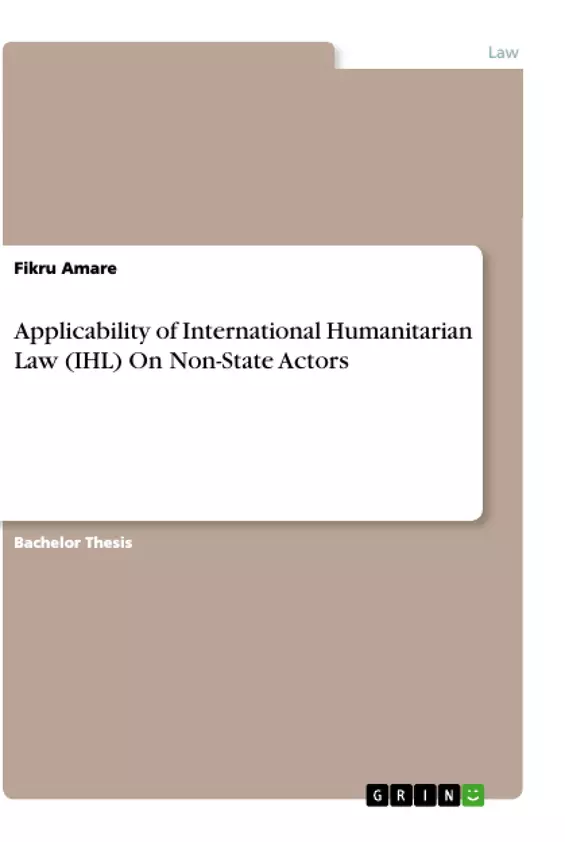In this paper the author addresses whether the international humanitarian law applicable in non state actors of armed conflict in the contemporary world. There is no long-lasting peace in the history of the human being. The world has passed through conflicts and wars for centuries. The Second World War was the most prominent and devastating in its nature. Millions of people were dead, world economic development being stagnated and millions of children became orphans. And hence, we peoples of the world are in a need to come up with compressive rules and procedures to govern the ongoing conflicts. That is why the International humanitarian law (here after called IHL) was designed.
IHL is a subject matter that regulates the conduct of war. IHL does not prevent war from being happened, rather it regulates the conduct of already happened war and it gives equal protection to those parties which are within the conflict without a need to observe their status in order to balance military necessity and humanity. While the very nature of twenty-one century warfare has arguably undergone significant developments in recent years, it is widely noted that non-State actors actively play an increasingly substantial role in contemporary violent conflicts. Although non-State actors have been fighting against States throughout history, they were subject to domestic law enforcement.
As the nature of war evolves due to non-state actors exerting influence, and subsequently their role as agents to armed conflict become prevailing around the world. Enhancing compliance with international norms by armed non-state actors is central to efforts to improve the protection of civilians in armed conflict. Limited engagement with such actors, as well as lack of clarity as to the precise nature and extent of the international legal regimes that are apply to them; constitute significant barriers to achieving better compliance. The spectrum of new types of non-state actors is broad, “encompassing a range of identities, motivations and varying degrees of willingness and ability, to observe IHL and other international law standards.’’
Inhaltsverzeichnis (Table of Contents)
- Chapter one
- 1. Introduction
- 1.1. Background of the study.
- 1.2 Statement of the problem
- 1.3 Objectives of the study
- 1.3.1 General objectives of the study
- 1.3.2 Specific objectives
- 1.4 Research questions
- 1.5 Significance of the study
- 1.6 Limitation of the study.
- 1.7 Organization of the study
- 1.8 Research methodology
- 1. Introduction
- Chapter two
- 2. Literature review
- 2.1 Non-State actors in the auspices of international law………………….
- 2.2 Non-State Actors (NSA)...
- 2.2.1 Characteristics of NSAS.........
- 2.2 2. Types of NSA
- 2. Literature review
- Chapter three
- 3. The application of international law in general and international Humanitarian law in
particular on Non-State Actors
- 3.1 The application of international law to non-state armed groups
- 3.2. Applicability of International Humanitarian Law (IHL)....
- 3.2.1 Provisions of Applicable Law.......
- I. Common Article 3 of the Geneva Conventions (GC).
- II. Additional Protocol II to the GC
- III. Rome Statute of the International Criminal Court (RSICC)..\n
- 3.2.2 Associated Aspects of the Application of IHL to the NSA
- 3.2.3 Responsibility of NSAs.....
- 3.2.1 Provisions of Applicable Law.......
- 3.3 Alternative Law and Its Concerns
- 3.3.1 Legitimacy Concern.
- 3. The application of international law in general and international Humanitarian law in
particular on Non-State Actors
- Chapter Four.........
- 4. Conclusion and Recommendations.
- 4.1 Conclusion.....
- 4.2 Recommendations
- 4. Conclusion and Recommendations.
Zielsetzung und Themenschwerpunkte (Objectives and Key Themes)
This thesis explores the applicability of International Humanitarian Law (IHL) to non-state actors (NSAs), examining the challenges and complexities of applying conventional international law to these entities. The main objective is to analyze the legal framework governing the application of IHL to NSAs, considering the specific characteristics and complexities of their actions. Key themes investigated include:- The definition and characteristics of NSAs in the context of international law.
- The challenges of applying international law to non-state armed groups.
- The relevant provisions of IHL applicable to NSAs, including the Geneva Conventions and Additional Protocol II.
- The responsibility of NSAs for violations of IHL.
- The potential implications and concerns surrounding alternative legal frameworks.
Zusammenfassung der Kapitel (Chapter Summaries)
- Chapter one provides an introduction to the study, outlining the background, statement of the problem, objectives, research questions, significance, limitations, organization, and research methodology. It sets the stage for the investigation into the applicability of IHL to NSAs.
- Chapter two delves into a review of existing literature on NSAs within the framework of international law. It explores the definition, characteristics, and types of NSAs, providing a foundational understanding of these actors within the legal landscape.
- Chapter three examines the application of international law, particularly IHL, to NSAs. It analyzes the challenges of applying international law to non-state armed groups, explores the provisions of applicable law, including Common Article 3 of the Geneva Conventions, Additional Protocol II, and the Rome Statute of the International Criminal Court. It also investigates the responsibility of NSAs for violations of IHL and discusses the implications and concerns surrounding alternative legal frameworks.
Schlüsselwörter (Keywords)
This thesis focuses on the applicability of international law, particularly International Humanitarian Law (IHL), to non-state actors (NSAs). It explores the challenges and complexities of applying conventional international law to these entities, considering their unique characteristics and the potential implications for the international legal framework. Key terms include: non-state actors, armed non-state actors, international humanitarian law, Geneva Conventions, Additional Protocol II, Rome Statute of the International Criminal Court, responsibility, alternative law.- Quote paper
- Fikru Amare (Author), 2022, Applicability of International Humanitarian Law (IHL) On Non-State Actors, Munich, GRIN Verlag, https://www.hausarbeiten.de/document/1184404


